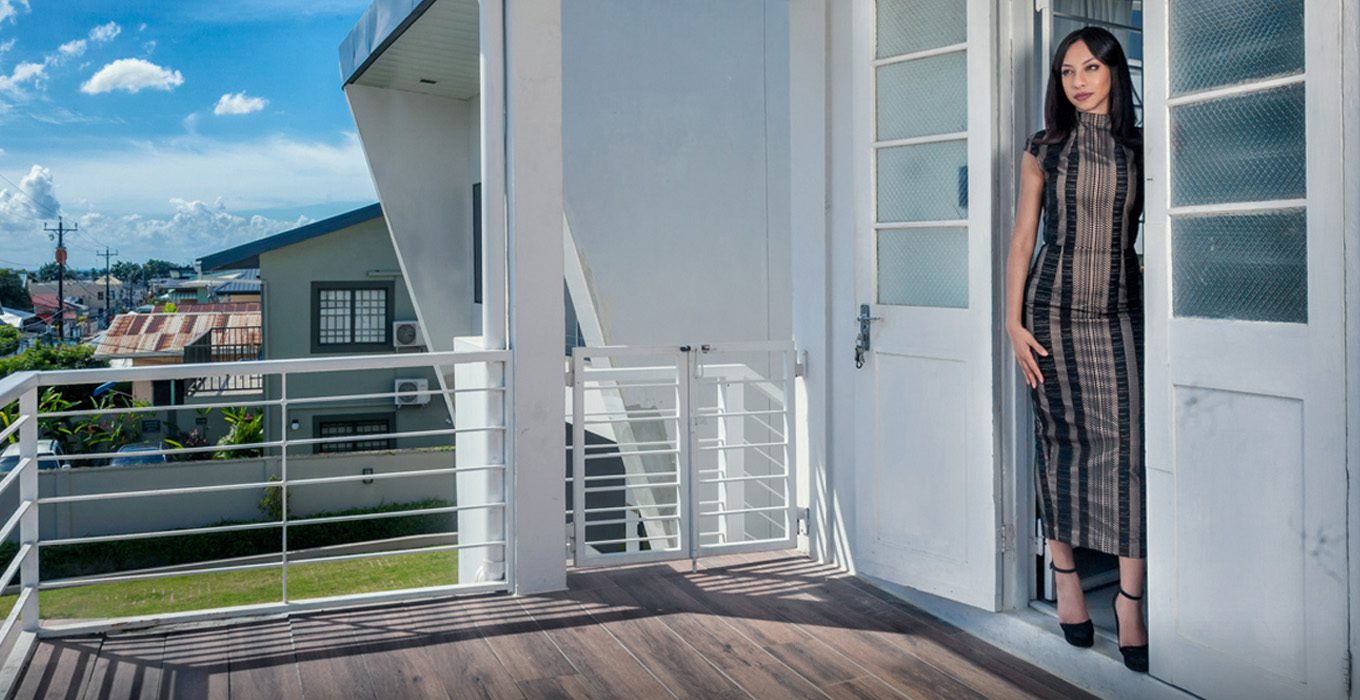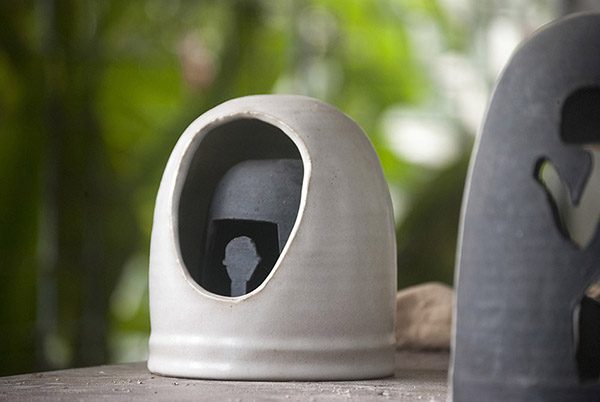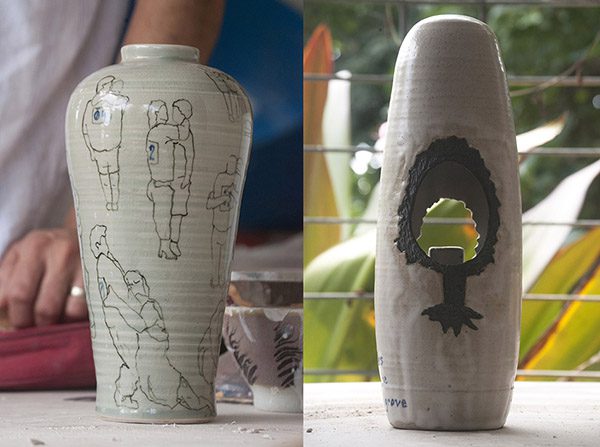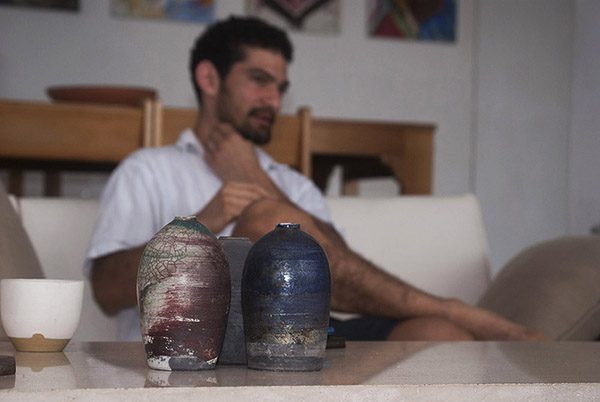

March 29, 2015
Using clay the way a painter uses canvas, Designer Island 2014 Loves List maker Adam Williams, uses simple forms to describe social and political stories on their surfaces. From the basic forms of collectible cups and wares to the rare allure of sculptured commentary, Adam’s patience, emotion and intent are molded to life, warmed to vibrant colour and welcome you in with unexpected beauty.
It’s Sunday morning in Diego Martin and two years since the potter’s last sojourn to the island. Inside, Adam’s family home feels patiently decorated with a curator’s eye: white walls hung with a mix of paintings, ceramics, pots on almost every surface and colourful glass bottles reflecting the sunlight through the frosted glass.
Wander around with us as Adam Williams puts form and beauty into his explorations of identity, romance, and life.
So, let’s start with your medium: why clay?
ADAM: In 2003, I was studying art at OCART – the Ontario College of Arts. I was a drawing and painting major, in the Figurative Drawing camp, and was told that I needed as many live model hours as possible. There was a little glitch in my schedule where I could have literally chosen anything. Ceramics fit and I got bitten by the bug.
It completely derailed that fantasy of the rat race of contemporary painting: move to New York, dominate the world, etc. I started to feel like painting was dead. Not dead. But, for me, it died. And clay just had everything.
Everything? What does clay have that painting doesn’t?
ADAM: Think of it this way: with painting, you stretch a canvas, now and then. With clay, you’re making and prepping, organising and gathering. Then firing, glazing, firing again. It’s so much more lively. Like learning a language, learning music… Richer. More diverse. Endless.
But it’s also simple, no? Handmade? Right now, it seems like everybody is really into handmade… everybody is making something. And everybody is talking about it.
ADAM: You’re absolutely correct. But here – and even in Canada – clay is not discussed. Where are the criticisms in Trinidad? Where are the reviews?
Many people who paint have some kind of art education, some kind of design training. And because so many people paint, there are different strata of careers of painters.
My problem with clay, and a lot of other craft, is many people come to clay by starting with clay: they didn’t start with art or design and take the time to get proficient. They might get proficient with the material and the tools, but they are completely inept with basic compositional and three-dimensional forms. If you can’t look good in cardboard, how will you look good in sterling silver?
While I think everyone should have access to the arts and a chance to make a living, there still needs to be criticism and a commitment to the fundamentals.
So are your parents artists?
ADAM: No. My parents aren’t artists. My mom is a retired nurse, my dad was in manufacturing; mom actually did A’Levels with Dr. Pat Bishop. So we were always allowed to draw as kids, and that just continued.
In school as well?
ADAM: Looking back, I was big on avoiding things: when I had homework, I would be painting. And then, when I should’ve been painting, I was in clay!
Growing up, I went to Maple Leaf, which is like an island within our island but also a haven: it was a great experience academically and, as a gay teenager, I was scared of the public school system – much less an all boys’ school! But, on the flip side, you’re really kind of separated from mainstream society and the culture, values and richness of living in such an interesting society.
I think that anyone who has moved away from their home wrestles with their identity, to some degree. I’ve been very lucky in that I haven’t suffered an ‘identity crisis’ but it is something which I try to make sense of: where do I fit? Not only living in Canada, where do I fit in Trinidad? The answer, at that time, was Maple Leaf.
And now it’s in pottery?
ADAM: Not quite… Right now, I divide my practice into sculpture work and pottery, both of which require all my time! It’s like cutting my brain in two…
Coming from painting, the pot becomes a 3D canvas so now I really explore things dimensionally, play with form, and ask, “What does this say?”
I quickly got into a groove of a very straightforward pot, which allowed me to play with the surface. And that does not make me a very good or well- rounded potter but that was what I chose.
But there is something to be said for being able to hone in on what you’re good at and explore the surface design, the colours and transform the clay into canvas. So how do you choose and make colours for your pieces and get them to blend and flow?
ADAM: Colour in ceramics is a tricky thing. Painters have an unlimited palette when they go to a shop. They invent new variations of colours all the time. It’s limitless.
But, with ceramics, there’s a big gap between what you’re doing and what you get. It’s kinda like looking at a paint chip and deciding to paint a whole house in that colour. After, you look at it and think: it’s not quite like this paint chip.
In the same way, you don’t know how clay is going to behave and you don’t have the benefit of an unlimited palette so you have no choice but to be resourceful.
Which comes back to the discussion of fundamentals. Grey scales, colour wheels, colour vibration, depth of field… All of these things are the backbone of effective design and turn a limited palette into a big one.
If you’ve come from a strong design background, you won’t be concerned with the exact colour. Your concern is with how it works. And so your concern becomes glaze. Because glaze isn’t paint. It moves. It melts. You open the kiln and, sometimes it’s definitely not what you expected – whether good or bad – and you move on.
But then, how are you actually able to get and mix colours?
ADAM: Without making it too complicated, it happens in the kiln. The kiln is a lot like a stove, with propane tanks and lines that run through burners. You ignite them and there is a flame burning and you turn up the temperature by turning up the gas every hour or so.
But the trick is in the minerals. You can change some minerals to get variations in colour by reducing the amount of air in the kiln. You virtually starve the flame in order to pull oxygen out of the air and out of the glaze.
Let’s go back to the simple form and simple shape. You’ve been doing your form for some time and some clay in your sculpture, but how is your time spent? Have you tried other things?
ADAM: I mostly stuck to it because I like making pots and used the surfaces for very dramatic purposes! The cup is simple or the bowl is simple, but I do illustrations on it, trying to use the glaze in very exciting ways.
Because, typically, you’re there alone, sipping a cup of coffee. A mug is familiar and comfortable. It’s not confusing or intimidating. It’s yours. But the glaze still allows it to be mine.
I am assuming that your mugs are your more popular items?
ADAM: Yes, in terms of popularity and as an item to purchase, they do better than bowls, or most other forms, even vases.
So, sculpturally, I have not pushed myself. Three dimensionally, I have not pushed myself in pottery very much. I focused on the imagery, and that alone is very difficult because you can’t just draw any image and slap it on a pottery. You have to think: why is that image or design relevant to that shape? What’s the point?
Picasso actually did a lot of pottery. Other people would make things on the wheel for him and he would just go crazy with them, citing it as a very good marriage between the surface and the shapes.
So while I sometimes get terrified about where to go next or even just doing it wrong, I just keep going.
How freeing!
ADAM: Kinda… but it’s really because I hate feedback! You have to recover from it, then you have to get on. I have stuff here that was in the garbage and, because of my mother, they’re now on the shelf.
That’s every mother! But do you do more work here or in Canada?
ADAM: Canada. This space actually doesn’t function during the year, and then I come back, dismantle it and work for a while.
The market is far more saturated up there with people who do clay. And it’s not just clay: you have a large community of jewellers and textile artistes. Locally, a number of clay people pop up every now and then, and they stop or they move away. So there is a definite demand, and whatever gets to Trinidad via people’s luggage or what I can do here, is a very healthy market.
So what’s next?
ADAM: Well, sculpturally, I feel like I am still at an infant stage, so this year and next year, I am not thinking of exhibiting. Instead, I’m going to spend time making a lot of bad art. Spend time in sculptural play…
Which is…
ADAM: Imagine a dance competition. Romantic Love is the narrative and Gay Male is the identity. And the common theme is women being critical of men and gay men being critical of men. It’s the oppressor and the oppressed, guilty of the same crime.
That’s sculptural play, which is a struggle for me. Is this a narrative with conceptual value? Will it play well in the art? Will it be appreciated?
Romantic love seems to translate well: simply watching and being watched.
Watching is a theme you’ve explored before in your social commentary sclptures?
ADAM: Yes. I remember years ago I was driving past the lighthouse with a friend and thought, “Have you ever seen a black lighthouse?”
So I made a black lighthouse with a black backdrop: black on black. This was around the time that there was a national dissatisfaction with the government and surveillance culture… so the lighthouse was about watching and being watched… Again, it was the idea of understanding what we knew to be true and how the country was moving, and how things were shifting.
I borrowed a culture of silhouettes from artists like Christopher Cozier. So I’ve always been grateful for the feedback I’ve gotten in Trinidad. Overseas, I see the sloppiness, which I could get away with here and, moving away, that was one thing that really cleaned up my craft. But, here, we have a comfort zone where I can immerse myself with graphic designers, architects, the literary crowd, the art crowd and engage. And when I go up there, it’s back into the clay world.
It’s interesting that you say, going into Canada, coming to the small island. Canada is the larger community.
ADAM: It’s true. But my interaction with the art world is limited in Canada. I run into people because I work with them, and we shit-talk, but then my work takes me away from everything. I enjoy working in my own space but I want to get more into things. So, I’ll be back.
Because the right amount of art happens here.
Thanks for taking the time to talk with us Adam and welcoming us into your family home. To see more of Adam’s work visit: adam-ceramics.





INTERVIEWER: TANYA MARIE PHOTOGRAPHER: CLAYTON RHULE